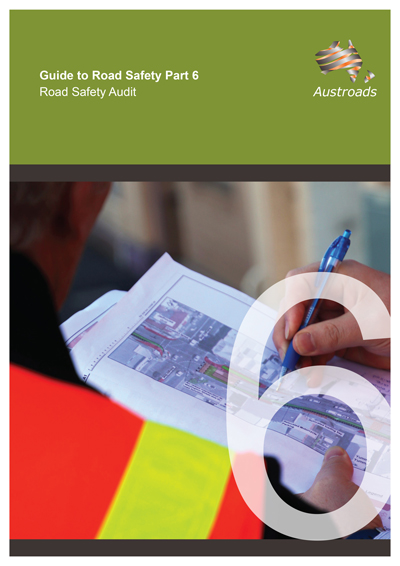Road Safety

- Publication no: AGRS06-22
- ISBN: 978-1-922700-22-3
- Published: 19 January 2022
- Edition: 6.0
- PDF (free) Download
Guide to Road Safety Part 6: Road Safety Audit provides practical guidance on the procurement, management and implementation of road safety audits.
This Guide has been developed within the current operating environment for auditing, setting a series of key principles which establish good practice to shape a local road safety audit strategy/policy.
Where practical issues necessitate, reasonable exemptions are supported, but must be formally justified and signed-off to ensure responsibility and accountability.
The importance of engaging non-road agency stakeholders in the audit process is also recognised and has been a major consideration in the practical nature of the guidance provided within this document.
Watch the webinar with Paul Hillier (Project Consultant), Joseph Le (Co-Project Manager) and Kenn Beer (Co-Project Manager and Technical Advisor).
This is the 6th edition of the Austroads Guide to Road Safety Auditing, and consolidates the 5th edition which was published in two parts; Parts 6 and 6A.
- 1. Introduction
- 1.1 Road Safety Auditing and its Contribution
- 1.2 Previous Austroads Guides
- 1.3 Development of This Guide
- 1.4 Guide Structure
- 1.5 Who Should Use This Guide and How Should They Use It?
- 2. The Key Features of RSA
- 2.1 Introduction
- 2.2 Why Designing to Standards and Guidelines does not Guarantee Safety
- 2.3 What are the Attributes of the Safest Roads?
- 2.4 Legal Considerations
- 2.5 Closing Summary of the Key Benefits of RSA
- 3. RSA Within a Road Safety Management Framework
- 3.1 Introduction
- 3.2 Explanation
- 3.3 Verification of Designs
- 4. The Operating Environment
- 4.1 Introduction
- 4.2 The Two Guiding Concepts
- 4.3 The Three Themes within the Operating Environment
- 4.3.1 Theme 1 – Raising Competency and Improving Outputs
- 4.3.2 Theme 2 – Audit Coverage
- 4.3.3 Theme 3 – Staying Relevant and Future Proofing
- 5. RSA within the Safe System
- 5.1 Introduction
- 5.2 Applying Safe System Principles in the RSA Process
- 5.3 Identifying Risk Mitigation Measures Under the Safe System
- 5.4 Safe System Assessments (SSA)
- 6. A Strategy for RSA
- 6.1 Introduction
- 6.1.1 New and Modified Road Infrastructure
- 6.1.2 Existing Roads
- 6.2 Developing a Local Strategy/Policy
- 6.3 What Can be Audited and When Should Audits be Undertaken?
- 6.4 Developing an Audit Schedule – New/Modified Road Infrastructure
- 6.5 Developing an Audit Schedule – Existing Roads
- 6.1 Introduction
- 7. Types of RSA
- 7.1 Feasibility (Strategic/Concept)
- 7.2 Preliminary Design
- 7.3 Detailed Design
- 7.4 Pre-opening
- 7.5 Immediate Post-opening (Post-completion)
- 7.6 Existing Road
- 7.7 Other Considerations
- 7.7.1 Interim and Repeat Audits
- 7.7.2 Thematic (Road User Specific) Audits
- 7.7.3 Road Safety Checks and Asset Management Inspections
- 7.7.4 Traffic Management
- 7.7.5 Road Related Areas
- 7.7.6 Emerging Technology
- 7.7.7 Maintainability Assessment
- 8. The RSA Process
- 8.1 Introduction
- 8.2 Client and Audit Teams
- 8.2.1 Client Team
- 8.2.2 Audit Team
- 8.3 Communications
- 8.4 The Responsibilities of the Client and Audit Teams
- 9. Commissioning Phase
- 9.1 Introduction
- 9.2 Preparing the Audit Brief
- 9.3 Providing Background Information
- 9.4 Selecting the Audit Team
- 9.4.1 Lead Auditor
- 9.4.2 Auditor
- 9.4.3 Additional Audit Attendees
- 9.5 Auditor Competency
- 9.6 Independence of the Audit Team
- 9.6.1 New and Modified Infrastructure
- 9.6.2 Existing Roads
- 9.6.3 Summary
- 10. Conducting Phase
- 10.1 Introduction
- 10.2 The Commencement Meeting
- 10.3 Analysing the Information Supplied
- 10.4 Undertaking the Audit – Identifying and Assessing Safety Risks and Hazards
- 10.4.1 The Road as a System
- 10.4.2 Prompt Lists and Front Loading
- 10.4.3 Planning Site Inspections
- 10.4.4 Considerations during the Site Inspection
- 10.4.5 Practical Aspects of Site Inspections
- 10.4.6 Practical Dilemmas when Conducting RSA
- 10.4.7 Site Inspection De-brief Meeting
- 10.5 Expressing and Prioritising Risks and Hazards
- 10.5.1 Risk Assessment
- 10.6 Making Recommendations
- 10.7 The Audit Report
- 10.8 Closing Summary – Conducting Stage
- 11. Completion and Implementation Phases
- 11.1 Introduction
- 11.2 Handover of Audit Report and the Completion Meeting
- 11.3 Reviewing the Audit Findings
- 11.4 Responding to the Audit Report
- 11.5 Importance of ‘Closing the Loop’
- 11.6 Retention of Records
- 11.7 Registration of Audits
- 12. Auditing at Local Government Level
- 13. Closing Remarks
- References
- Appendix A Key Terms
- Appendix B Legal Issues
- B.1 Key Messages from this Section
- B.2 Context – Civil Claims against Road Agencies
- B.3 The Positive Contribution of RSA
- B.4 Procuring an Audit and ‘Closing the Loop’
- B.5 Personal Professional Liability of Auditors
- B.6 The Future – Could RSAs Become Mandatory?
- Appendix C Example Local RSA Strategy/Policy
- C.1 State Road Agency Example
- C.2 Local Road Agency Example
- Appendix D Examples of Safety Risks and Hazards by Audit Type
- D.1 Design and Pre-opening Audits
- D.2 Existing Roads
- Appendix E Specimen Audit Brief
- Appendix F Specimen Audit Findings Proforma and Audit Report
- F.1 Example Audit Finding Proforma (Top Table) and Case Study Learning Example (Bottom Table)
- F.2 Example Audit Report
- Appendix G Example Auditor Code of Conduct
- Appendix H Prompt Lists
- H.1 Principles
- H.2 Prompt List for Front Loading
- H.3 Prompt List covering Local Alignment
- H.4 Prompt List covering General Aspects
- H.5 Prompt List covering Intersections
- H.6 Prompt List covering Walking and Cycling
- H.7 Prompt List covering Traffic Signs, Line Markings and Lighting
- Appendix I Fact Sheets on Thematic Audits
- I.1 Pedestrians
- I.2 Cycling
- I.3 Motorcycle
- Appendix J Potential Ideas for the On-going Development of RSA
